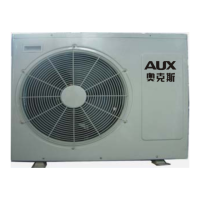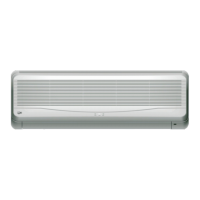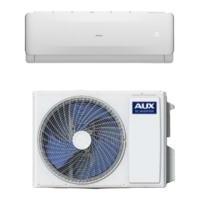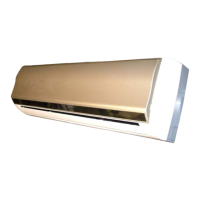AUX air conditioner service manual
When the air-conditioner runs the heating mode, the loop of the solenoid guiding valve is electrified
and the iron core drives the valve bowl to move right. Then the capillary tube a connects to d (in high
pressure) and b connects to c (in low pressure). Because the capillaries a and d connect with the
discharge pipe of compressor, they will form a high-pressure zone being filled with the high-pressure
gas. However the capillaries b and c connect with the suction pipe of the compressor, they will form a
low-pressure zone. At this moment, the piston moves to the right side by pressure, then, D connects to
E, the high-pressure gas refrigerant in D pipe flows into the indoor heat exchanger (as condenser) for
heat transmission process passing through pipe E, and enters into the outdoor heat-exchanger
(evaporator) passing through capillary tube. Finally, it will enter into pipe S from pipe C and return
back to the compressor for concluding a heating cycle. The flow process is indicated in Chart 2:
②one-way Valve
Check valve is also called anti-reverse valve. it permits the refrigerant to flow in only one direction in
the refrigeration system, and to be installed in the pipes for preventing process flow from
reversing. It is mainly applied in the heat pump air-conditioner and adopted as the assistant to the
electromagnetic reversing valve for changing the refrigerant’s flow direction and the system’s pressure.
Generally, there is an arrow marked on the outer surface of the one-way valve for indicating the flow
direction of the refrigerant.
The one-way valve is divided into the spherical valve and the needle valve. They are in the simple
structure. For example in the below picture, when the refrigerant flows in the direction as the arrow
indicates and when the pressure at A side is higher than the one at B side, then the steel ball (or valve
needle) moves to the left side, and the refrigerant flows from A to B, the one-way valve opens.
However, when the refrigerant flows in a reverse direction and when the pressure at B side is higher
than the one at A side, then the steel ball (or valve needle) moves to the right side, which jams the
25
